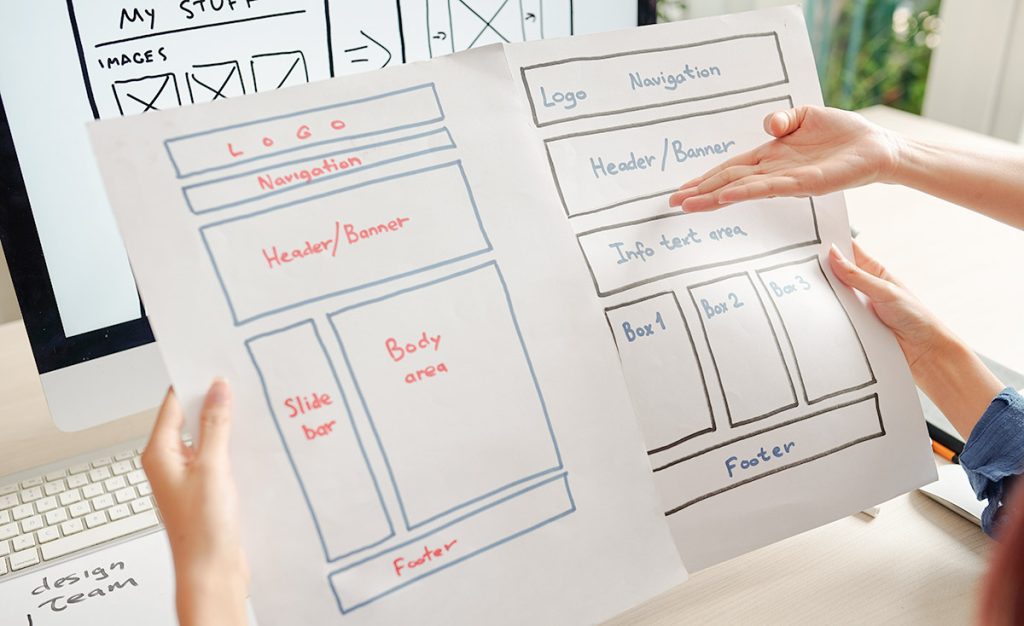

Consistency in web design refers to using similar elements and design principles throughout a website. A predictable layout enhances website navigation and comprehension, as it maintains consistency. Consistency guarantees a cohesive appearance and seamless functionality for your website’s various components, including headers, footers, sidebars, and navigation bars. It also:
- User friendly
- Improves productivity
- improves usability and learnability
- saves money and time on design
Consistent navigation
Consistent navigation helps users who may have trouble moving around a website. Users should find it easy to move between pages and always know where they are on the website. Make sure your website’s navigation is clear and consistent, as confusing navigation might make them leave your site.
Page layouts and menu structure
Using templates to establish a consistent page layout throughout your website is a smart approach. Maintain smooth transitions between pages by incorporating uniform elements on each page. For example:
- consistency menus on each page
- consistency fonts and colours across your site
- clear and consistent visual hierarchy to the elements on your page
- ensure that your business logo visible on each page
- Ensure that your logo is a clickable link leading back to the homepage.consistency search box location on each page
Placing marketing messages and ‘calls to action,’ like signing up for newsletters or showcasing special offers and discounts, is strongly advised. Position these prominently, as their placement can boost customer response rates.
Fonts and typography
Fonts and typography is an important player in web design. Font and typography plays a critical role on any website by ensuring we can comfortably read and process all its text-based content. Opting for standard fonts and defining a font family is a recommended approach. This minimizes the chance of the page being shown with system fonts, changing the look of the page.
Branding in web design
Designing a website with brand consistency. Your brand is the narrative that links individuals to the products and services you provide. Elements ranging from colors and fonts to language and layout convey your brand identity. Your website should:
- reinforce your corporate brand
- consistently use your company logo accross the site
- roll with your colour wheel
- keep your design simple
- accent your content with images
As you ensure your website remains consistent with your brand, remember the importance of making it accessible and user-friendly.
What Are The Advantages Of Consistency In Web Design?
Consistency in web design yields numerous benefits, primarily enhancing the user experience. By meeting user expectations through a consistent design, visitors find it easier to navigate the website, locate information, and complete desired actions. This positive user experience increases engagement and the likelihood of converting visitors into customers or subscribers.
A consistent design also reinforces a brand’s identity and message, effectively leaving a lasting impression on users. When users encounter a website with coherent visual language, they are more likely to trust the brand and perceive it as reliable and professional.
Moreover, internal consistency, such as uniform navigation and UI elements, minimizes confusion and frustration. Users can move through the website seamlessly, understanding the interface and interactions without relearning or adapting to new designs on each page.
How to Be Consistent in Your Designs
Consistency in web design is not mere luck; it requires a deliberate and strategic approach. To ensure a harmonious and cohesive user experience, follow these fundamental principles and actionable steps:
Develop a Comprehensive Style Guide
A style guide serves as the backbone of your website’s design consistency. Create a comprehensive document that outlines your color palette, typography, button styles, iconography, and other essential design elements. By having a unified reference point, all team members involved in the design process can adhere to a shared visual language, reinforcing your brand identity across the entire website.
Maintain a Consistent Layout
A well-organized and predictable layout enhances user navigation and reduces friction. Keep the placement of essential elements, such as navigation menus, logos, and calls to action, consistent across different pages. Users should easily recognize and access these elements, regardless of the page they are on, ensuring a smooth and intuitive journey through your website.
Adopt a Cohesive Color Palette
Select a color palette that complements your brand’s identity and resonates with your target audience. Consistently apply these colors throughout your website, from the header to the footer. Users can quickly recognize patterns by using the same colors for similar elements, reinforcing their familiarity with your brand.
Prioritize Visual Consistency
Ensure images, icons, and graphics follow a consistent style and visual language. Uniformity in image sizes, resolutions, and styles creates a cohesive and professional appearance. Avoid mixing various visual styles, creating confusion and diminishing the overall user experience.
Embrace Responsive Design
Responsive design is essential in today’s multi-device world. Ensure your website looks and functions consistently across various devices, including desktops, tablets, and smartphones. Test your site’s responsiveness to guarantee a seamless experience, regardless of the screen size, orientation, or platform.
Test and Gather Feedback
Continuous testing is crucial to identify potential inconsistencies or issues in your web design. Conduct usability testing with real users to gauge their experiences and gather feedback. Based on their input, make necessary adjustments to optimize the user journey and enhance overall satisfaction.
Implement Iterative Improvements
Web design is an iterative process, and consistency evolves. Continuously monitor user behavior and analyze website performance metrics. Based on the insights gained, make data-driven decisions to refine and improve your website’s design.
Train and Educate Team Members
Consistency is a collaborative effort, requiring all team members to be on the same page. Conduct training sessions and workshops to educate designers, developers, and content creators about the importance of consistency and how to implement it effectively.
How can we help
At Premia TNC, we offer comprehensive web design services to help you achieve a consistent and visually captivating online presence. Our team conducts in-depth brand and audience analysis to tailor a unique design that aligns with your goals.
We create custom web designs, develop style guides, and ensure responsive designs for seamless user experiences across various devices. Our focus on optimizing user experience and aligning content tone and voice enhances engagement and credibility. Partner with us to build a compelling digital experience that sets you apart in the competitive online landscape.
Frequently asked questions
Q1. Why is consistency in web design crucial for user experience?
A. Consistency in web design enhances user experience by meeting user expectations, making navigation more straightforward, and fostering trust and credibility.
Q2. What if my brand identity changes in the future?
A. If your brand identity changes, updating the style guide and design elements is essential to maintain consistency.
Q3. Is working with an expert web designer necessary?
A. While it's possible to design a website independently, a professional web designer can ensure a more polished and consistent outcome, ultimately benefiting your online presence.
Q4: Does consistency limit creativity in web design?
A: Consistency doesn't stifle creativity but provides a solid foundation for creative expression. A consistent framework allows designers to explore innovative solutions while maintaining a cohesive user experience.
Q5: How does consistency affect user trust and credibility?
A: Consistency instills trust and credibility in users. When a website appears coherent and professional, users perceive it as reliable and trustworthy, fostering long-term relationships and encouraging repeat visits.





















